Financial Reporting Analysis: Star Hub and Singtel Companies
VerifiedAdded on 2022/12/26
|6
|1333
|29
Report
AI Summary
This report provides a comprehensive analysis of financial reporting, focusing on key aspects such as qualitative characteristics, contract assets, and impairment losses. The report delves into the significance of relevance and faithful representation within financial information, highlighting how these attributes impact decision-making for stakeholders. It explores the concept of contract assets, differentiating them from trade receivables and discussing their treatment under IFRS 15. Furthermore, the report examines impairment losses, outlining the indicators used to assess them and their impact on a company's financial performance, with specific examples from Star Hub Company. Finally, it addresses accounting policies for intangible assets, particularly goodwill, and how these are reported on the balance sheet. The analysis incorporates data from Singtel and Star Hub Company's annual reports, providing real-world examples to illustrate the concepts discussed.
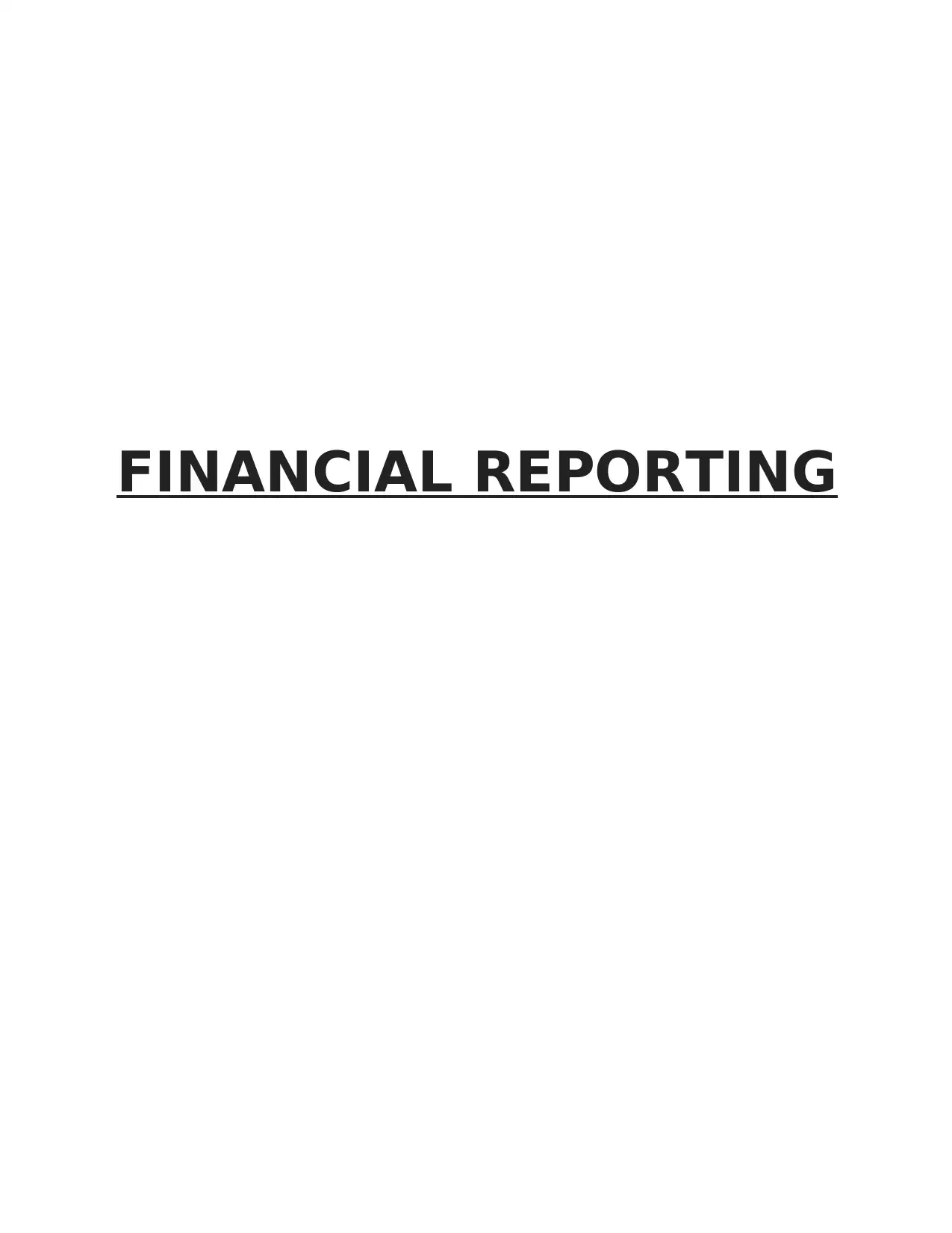
FINANCIAL REPORTING
Paraphrase This Document
Need a fresh take? Get an instant paraphrase of this document with our AI Paraphraser
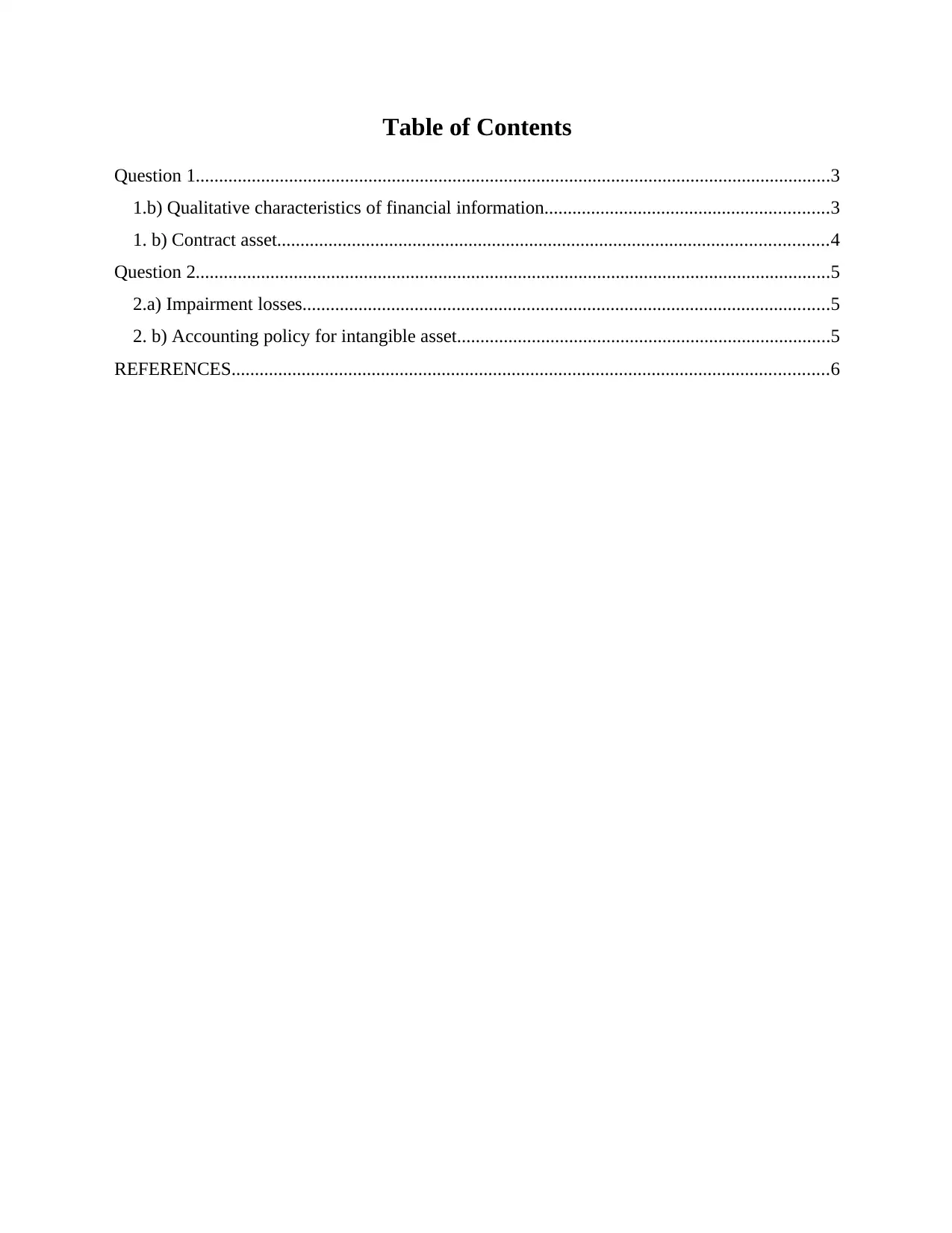
Table of Contents
Question 1........................................................................................................................................3
1.b) Qualitative characteristics of financial information.............................................................3
1. b) Contract asset......................................................................................................................4
Question 2........................................................................................................................................5
2.a) Impairment losses.................................................................................................................5
2. b) Accounting policy for intangible asset................................................................................5
REFERENCES................................................................................................................................6
Question 1........................................................................................................................................3
1.b) Qualitative characteristics of financial information.............................................................3
1. b) Contract asset......................................................................................................................4
Question 2........................................................................................................................................5
2.a) Impairment losses.................................................................................................................5
2. b) Accounting policy for intangible asset................................................................................5
REFERENCES................................................................................................................................6
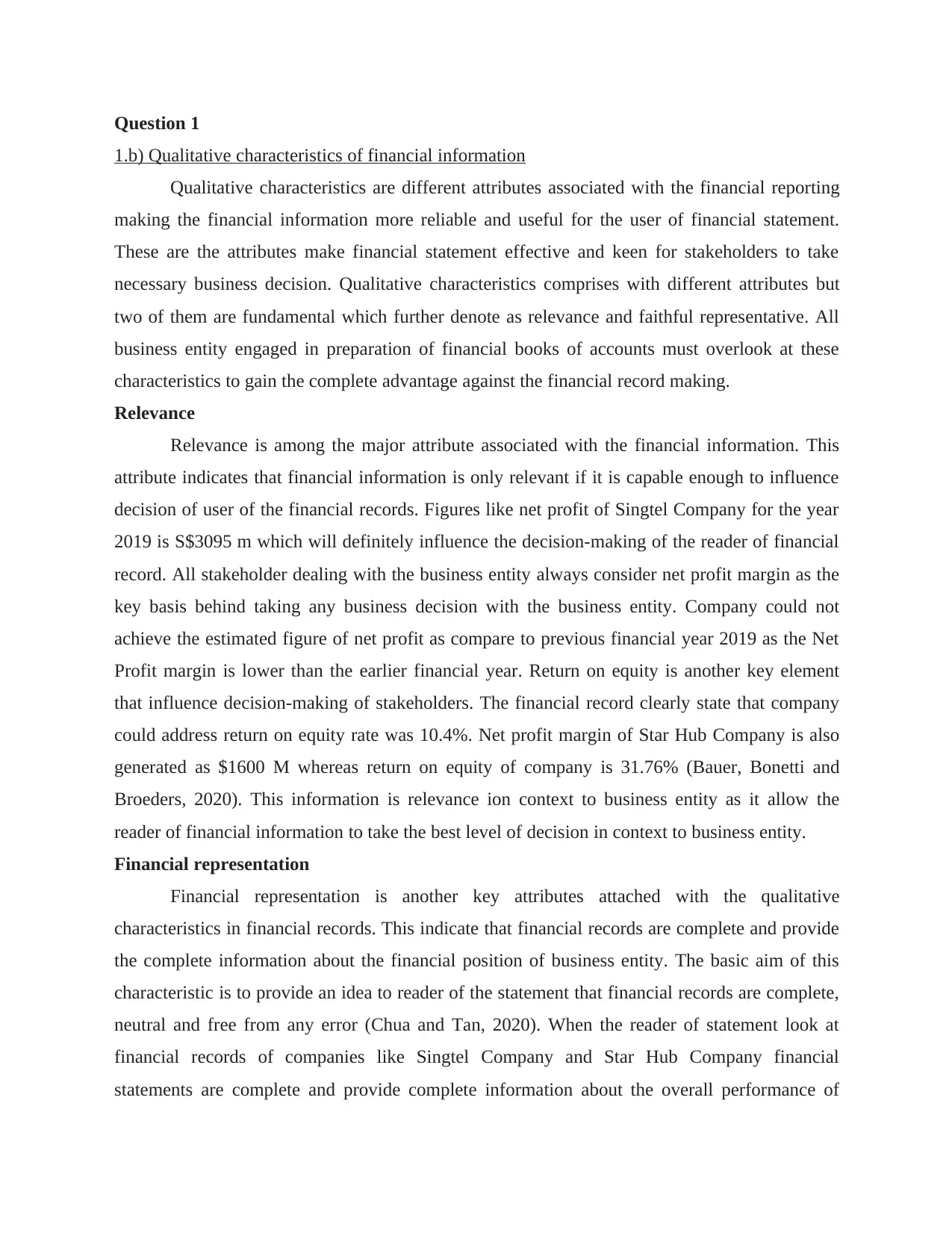
Question 1
1.b) Qualitative characteristics of financial information
Qualitative characteristics are different attributes associated with the financial reporting
making the financial information more reliable and useful for the user of financial statement.
These are the attributes make financial statement effective and keen for stakeholders to take
necessary business decision. Qualitative characteristics comprises with different attributes but
two of them are fundamental which further denote as relevance and faithful representative. All
business entity engaged in preparation of financial books of accounts must overlook at these
characteristics to gain the complete advantage against the financial record making.
Relevance
Relevance is among the major attribute associated with the financial information. This
attribute indicates that financial information is only relevant if it is capable enough to influence
decision of user of the financial records. Figures like net profit of Singtel Company for the year
2019 is S$3095 m which will definitely influence the decision-making of the reader of financial
record. All stakeholder dealing with the business entity always consider net profit margin as the
key basis behind taking any business decision with the business entity. Company could not
achieve the estimated figure of net profit as compare to previous financial year 2019 as the Net
Profit margin is lower than the earlier financial year. Return on equity is another key element
that influence decision-making of stakeholders. The financial record clearly state that company
could address return on equity rate was 10.4%. Net profit margin of Star Hub Company is also
generated as $1600 M whereas return on equity of company is 31.76% (Bauer, Bonetti and
Broeders, 2020). This information is relevance ion context to business entity as it allow the
reader of financial information to take the best level of decision in context to business entity.
Financial representation
Financial representation is another key attributes attached with the qualitative
characteristics in financial records. This indicate that financial records are complete and provide
the complete information about the financial position of business entity. The basic aim of this
characteristic is to provide an idea to reader of the statement that financial records are complete,
neutral and free from any error (Chua and Tan, 2020). When the reader of statement look at
financial records of companies like Singtel Company and Star Hub Company financial
statements are complete and provide complete information about the overall performance of
1.b) Qualitative characteristics of financial information
Qualitative characteristics are different attributes associated with the financial reporting
making the financial information more reliable and useful for the user of financial statement.
These are the attributes make financial statement effective and keen for stakeholders to take
necessary business decision. Qualitative characteristics comprises with different attributes but
two of them are fundamental which further denote as relevance and faithful representative. All
business entity engaged in preparation of financial books of accounts must overlook at these
characteristics to gain the complete advantage against the financial record making.
Relevance
Relevance is among the major attribute associated with the financial information. This
attribute indicates that financial information is only relevant if it is capable enough to influence
decision of user of the financial records. Figures like net profit of Singtel Company for the year
2019 is S$3095 m which will definitely influence the decision-making of the reader of financial
record. All stakeholder dealing with the business entity always consider net profit margin as the
key basis behind taking any business decision with the business entity. Company could not
achieve the estimated figure of net profit as compare to previous financial year 2019 as the Net
Profit margin is lower than the earlier financial year. Return on equity is another key element
that influence decision-making of stakeholders. The financial record clearly state that company
could address return on equity rate was 10.4%. Net profit margin of Star Hub Company is also
generated as $1600 M whereas return on equity of company is 31.76% (Bauer, Bonetti and
Broeders, 2020). This information is relevance ion context to business entity as it allow the
reader of financial information to take the best level of decision in context to business entity.
Financial representation
Financial representation is another key attributes attached with the qualitative
characteristics in financial records. This indicate that financial records are complete and provide
the complete information about the financial position of business entity. The basic aim of this
characteristic is to provide an idea to reader of the statement that financial records are complete,
neutral and free from any error (Chua and Tan, 2020). When the reader of statement look at
financial records of companies like Singtel Company and Star Hub Company financial
statements are complete and provide complete information about the overall performance of
⊘ This is a preview!⊘
Do you want full access?
Subscribe today to unlock all pages.

Trusted by 1+ million students worldwide
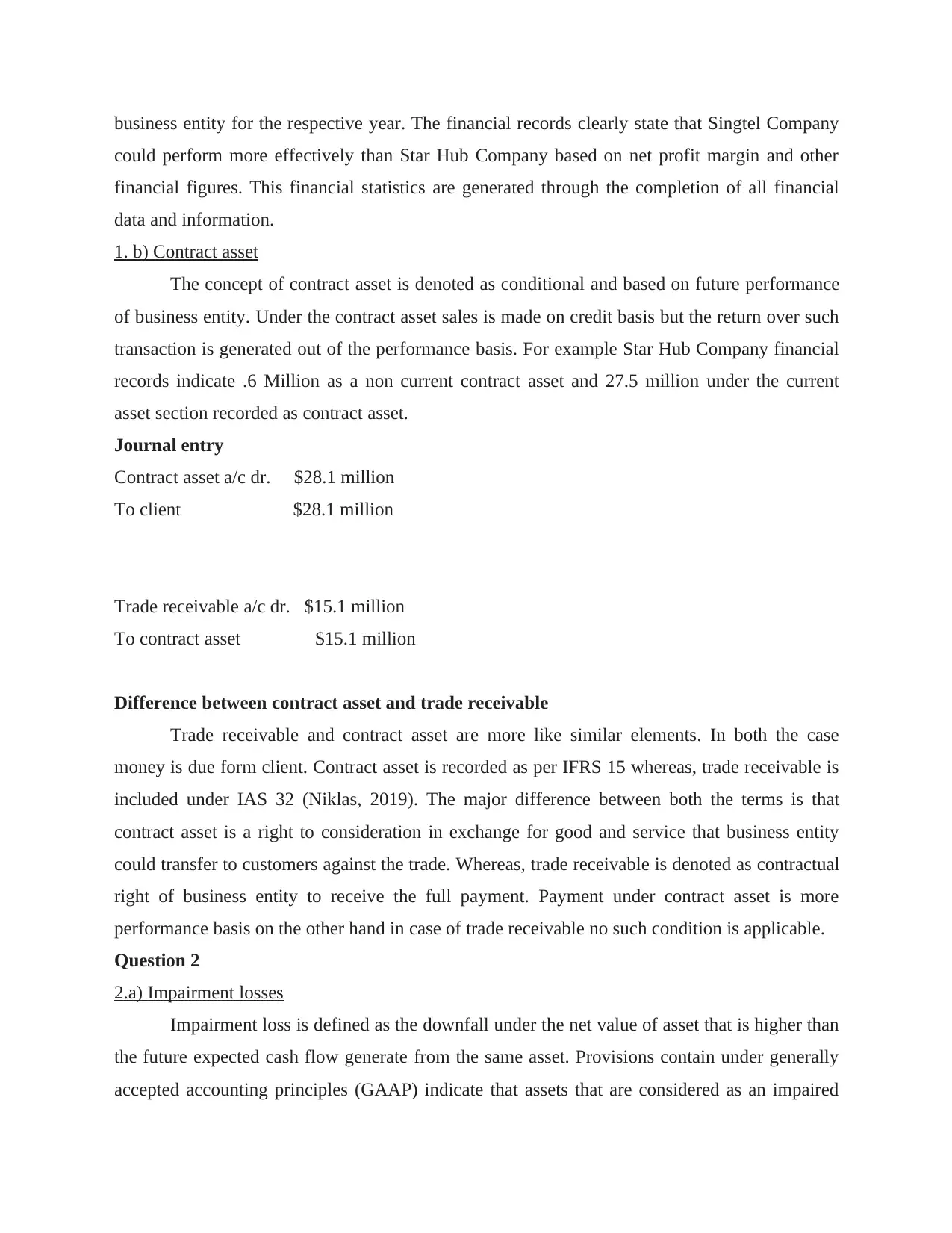
business entity for the respective year. The financial records clearly state that Singtel Company
could perform more effectively than Star Hub Company based on net profit margin and other
financial figures. This financial statistics are generated through the completion of all financial
data and information.
1. b) Contract asset
The concept of contract asset is denoted as conditional and based on future performance
of business entity. Under the contract asset sales is made on credit basis but the return over such
transaction is generated out of the performance basis. For example Star Hub Company financial
records indicate .6 Million as a non current contract asset and 27.5 million under the current
asset section recorded as contract asset.
Journal entry
Contract asset a/c dr. $28.1 million
To client $28.1 million
Trade receivable a/c dr. $15.1 million
To contract asset $15.1 million
Difference between contract asset and trade receivable
Trade receivable and contract asset are more like similar elements. In both the case
money is due form client. Contract asset is recorded as per IFRS 15 whereas, trade receivable is
included under IAS 32 (Niklas, 2019). The major difference between both the terms is that
contract asset is a right to consideration in exchange for good and service that business entity
could transfer to customers against the trade. Whereas, trade receivable is denoted as contractual
right of business entity to receive the full payment. Payment under contract asset is more
performance basis on the other hand in case of trade receivable no such condition is applicable.
Question 2
2.a) Impairment losses
Impairment loss is defined as the downfall under the net value of asset that is higher than
the future expected cash flow generate from the same asset. Provisions contain under generally
accepted accounting principles (GAAP) indicate that assets that are considered as an impaired
could perform more effectively than Star Hub Company based on net profit margin and other
financial figures. This financial statistics are generated through the completion of all financial
data and information.
1. b) Contract asset
The concept of contract asset is denoted as conditional and based on future performance
of business entity. Under the contract asset sales is made on credit basis but the return over such
transaction is generated out of the performance basis. For example Star Hub Company financial
records indicate .6 Million as a non current contract asset and 27.5 million under the current
asset section recorded as contract asset.
Journal entry
Contract asset a/c dr. $28.1 million
To client $28.1 million
Trade receivable a/c dr. $15.1 million
To contract asset $15.1 million
Difference between contract asset and trade receivable
Trade receivable and contract asset are more like similar elements. In both the case
money is due form client. Contract asset is recorded as per IFRS 15 whereas, trade receivable is
included under IAS 32 (Niklas, 2019). The major difference between both the terms is that
contract asset is a right to consideration in exchange for good and service that business entity
could transfer to customers against the trade. Whereas, trade receivable is denoted as contractual
right of business entity to receive the full payment. Payment under contract asset is more
performance basis on the other hand in case of trade receivable no such condition is applicable.
Question 2
2.a) Impairment losses
Impairment loss is defined as the downfall under the net value of asset that is higher than
the future expected cash flow generate from the same asset. Provisions contain under generally
accepted accounting principles (GAAP) indicate that assets that are considered as an impaired
Paraphrase This Document
Need a fresh take? Get an instant paraphrase of this document with our AI Paraphraser
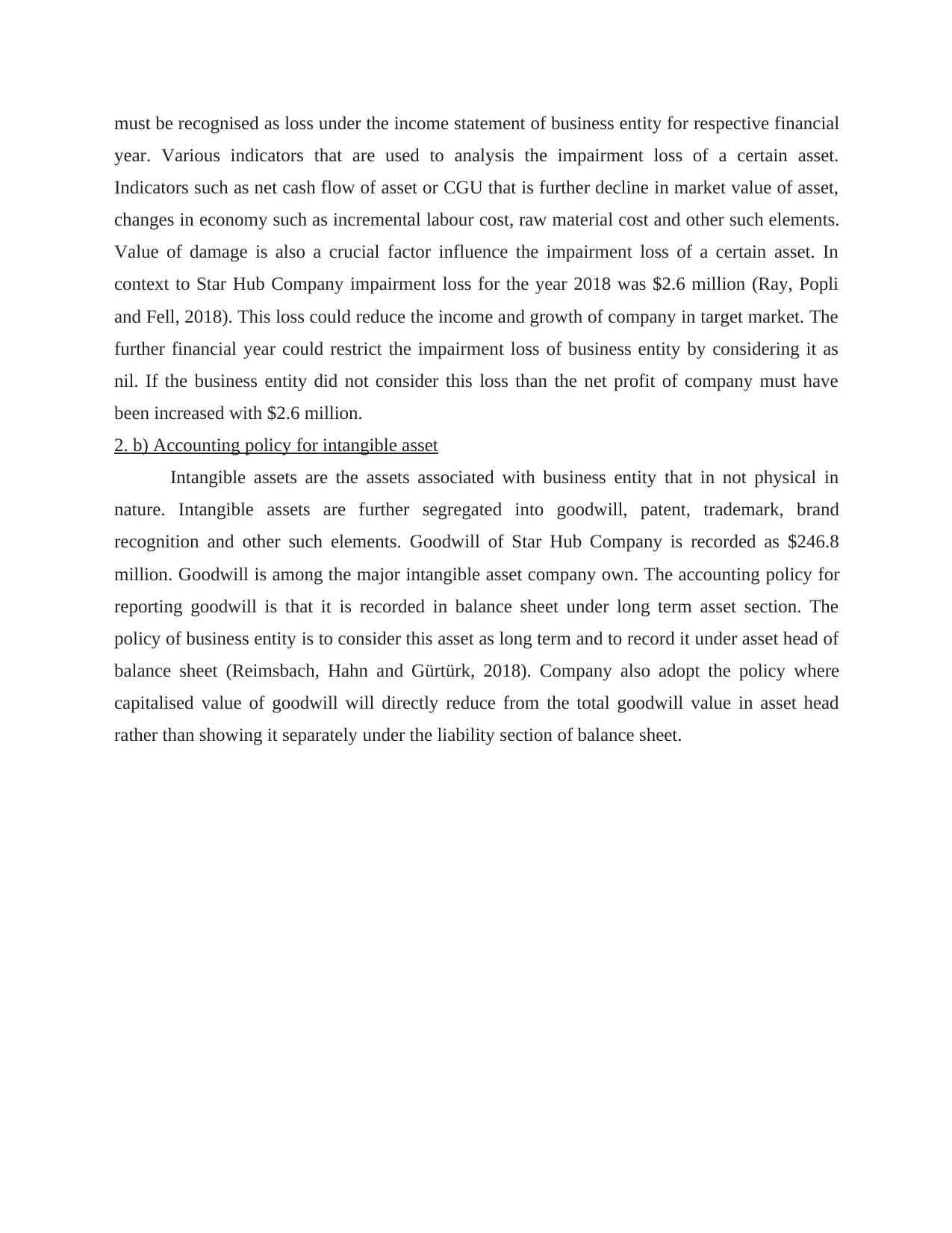
must be recognised as loss under the income statement of business entity for respective financial
year. Various indicators that are used to analysis the impairment loss of a certain asset.
Indicators such as net cash flow of asset or CGU that is further decline in market value of asset,
changes in economy such as incremental labour cost, raw material cost and other such elements.
Value of damage is also a crucial factor influence the impairment loss of a certain asset. In
context to Star Hub Company impairment loss for the year 2018 was $2.6 million (Ray, Popli
and Fell, 2018). This loss could reduce the income and growth of company in target market. The
further financial year could restrict the impairment loss of business entity by considering it as
nil. If the business entity did not consider this loss than the net profit of company must have
been increased with $2.6 million.
2. b) Accounting policy for intangible asset
Intangible assets are the assets associated with business entity that in not physical in
nature. Intangible assets are further segregated into goodwill, patent, trademark, brand
recognition and other such elements. Goodwill of Star Hub Company is recorded as $246.8
million. Goodwill is among the major intangible asset company own. The accounting policy for
reporting goodwill is that it is recorded in balance sheet under long term asset section. The
policy of business entity is to consider this asset as long term and to record it under asset head of
balance sheet (Reimsbach, Hahn and Gürtürk, 2018). Company also adopt the policy where
capitalised value of goodwill will directly reduce from the total goodwill value in asset head
rather than showing it separately under the liability section of balance sheet.
year. Various indicators that are used to analysis the impairment loss of a certain asset.
Indicators such as net cash flow of asset or CGU that is further decline in market value of asset,
changes in economy such as incremental labour cost, raw material cost and other such elements.
Value of damage is also a crucial factor influence the impairment loss of a certain asset. In
context to Star Hub Company impairment loss for the year 2018 was $2.6 million (Ray, Popli
and Fell, 2018). This loss could reduce the income and growth of company in target market. The
further financial year could restrict the impairment loss of business entity by considering it as
nil. If the business entity did not consider this loss than the net profit of company must have
been increased with $2.6 million.
2. b) Accounting policy for intangible asset
Intangible assets are the assets associated with business entity that in not physical in
nature. Intangible assets are further segregated into goodwill, patent, trademark, brand
recognition and other such elements. Goodwill of Star Hub Company is recorded as $246.8
million. Goodwill is among the major intangible asset company own. The accounting policy for
reporting goodwill is that it is recorded in balance sheet under long term asset section. The
policy of business entity is to consider this asset as long term and to record it under asset head of
balance sheet (Reimsbach, Hahn and Gürtürk, 2018). Company also adopt the policy where
capitalised value of goodwill will directly reduce from the total goodwill value in asset head
rather than showing it separately under the liability section of balance sheet.
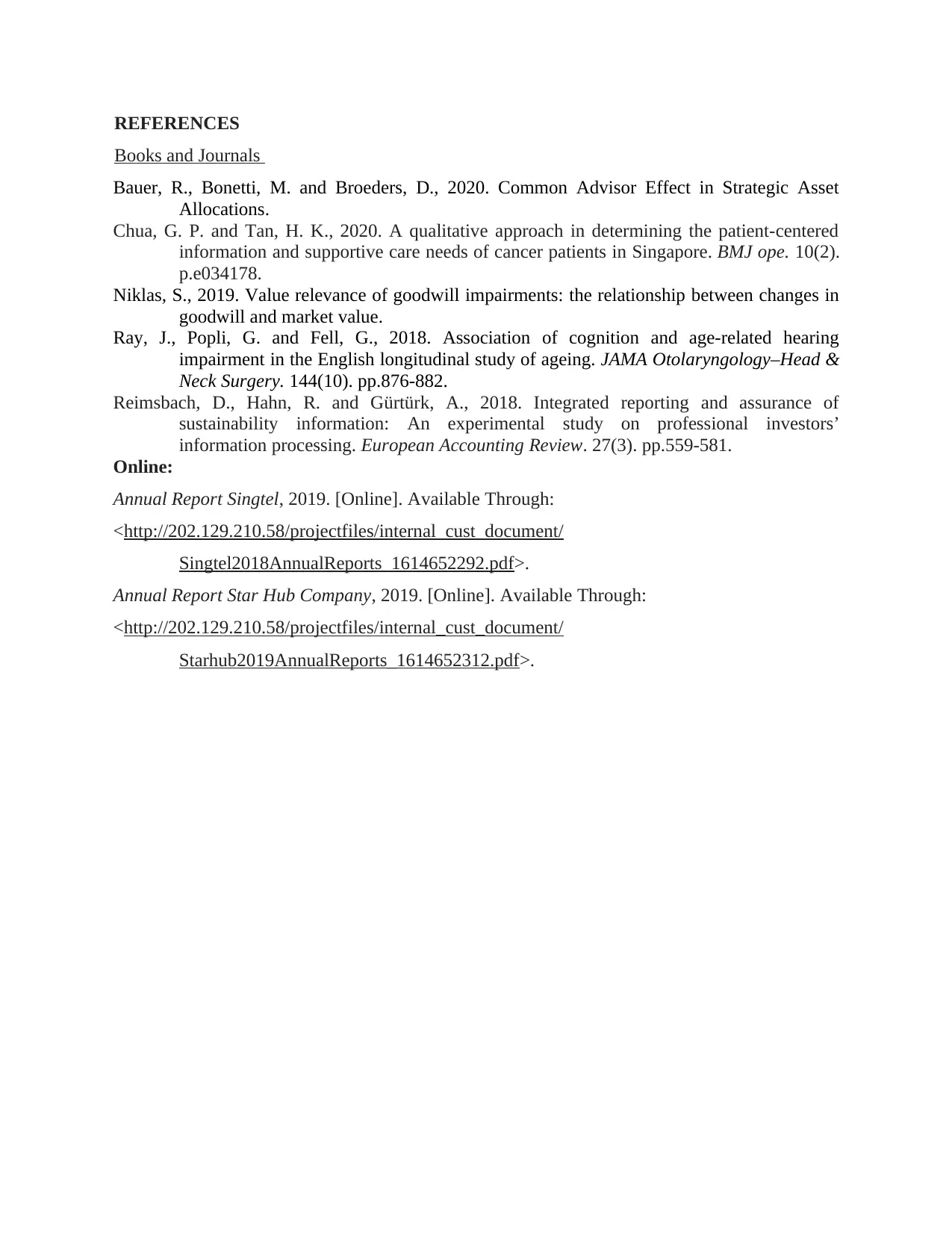
REFERENCES
Books and Journals
Bauer, R., Bonetti, M. and Broeders, D., 2020. Common Advisor Effect in Strategic Asset
Allocations.
Chua, G. P. and Tan, H. K., 2020. A qualitative approach in determining the patient-centered
information and supportive care needs of cancer patients in Singapore. BMJ ope. 10(2).
p.e034178.
Niklas, S., 2019. Value relevance of goodwill impairments: the relationship between changes in
goodwill and market value.
Ray, J., Popli, G. and Fell, G., 2018. Association of cognition and age-related hearing
impairment in the English longitudinal study of ageing. JAMA Otolaryngology–Head &
Neck Surgery. 144(10). pp.876-882.
Reimsbach, D., Hahn, R. and Gürtürk, A., 2018. Integrated reporting and assurance of
sustainability information: An experimental study on professional investors’
information processing. European Accounting Review. 27(3). pp.559-581.
Online:
Annual Report Singtel, 2019. [Online]. Available Through:
<http://202.129.210.58/projectfiles/internal_cust_document/
Singtel2018AnnualReports_1614652292.pdf>.
Annual Report Star Hub Company, 2019. [Online]. Available Through:
<http://202.129.210.58/projectfiles/internal_cust_document/
Starhub2019AnnualReports_1614652312.pdf>.
Books and Journals
Bauer, R., Bonetti, M. and Broeders, D., 2020. Common Advisor Effect in Strategic Asset
Allocations.
Chua, G. P. and Tan, H. K., 2020. A qualitative approach in determining the patient-centered
information and supportive care needs of cancer patients in Singapore. BMJ ope. 10(2).
p.e034178.
Niklas, S., 2019. Value relevance of goodwill impairments: the relationship between changes in
goodwill and market value.
Ray, J., Popli, G. and Fell, G., 2018. Association of cognition and age-related hearing
impairment in the English longitudinal study of ageing. JAMA Otolaryngology–Head &
Neck Surgery. 144(10). pp.876-882.
Reimsbach, D., Hahn, R. and Gürtürk, A., 2018. Integrated reporting and assurance of
sustainability information: An experimental study on professional investors’
information processing. European Accounting Review. 27(3). pp.559-581.
Online:
Annual Report Singtel, 2019. [Online]. Available Through:
<http://202.129.210.58/projectfiles/internal_cust_document/
Singtel2018AnnualReports_1614652292.pdf>.
Annual Report Star Hub Company, 2019. [Online]. Available Through:
<http://202.129.210.58/projectfiles/internal_cust_document/
Starhub2019AnnualReports_1614652312.pdf>.
⊘ This is a preview!⊘
Do you want full access?
Subscribe today to unlock all pages.

Trusted by 1+ million students worldwide
1 out of 6
Related Documents
Your All-in-One AI-Powered Toolkit for Academic Success.
+13062052269
info@desklib.com
Available 24*7 on WhatsApp / Email
![[object Object]](/_next/static/media/star-bottom.7253800d.svg)
Unlock your academic potential
Copyright © 2020–2025 A2Z Services. All Rights Reserved. Developed and managed by ZUCOL.





